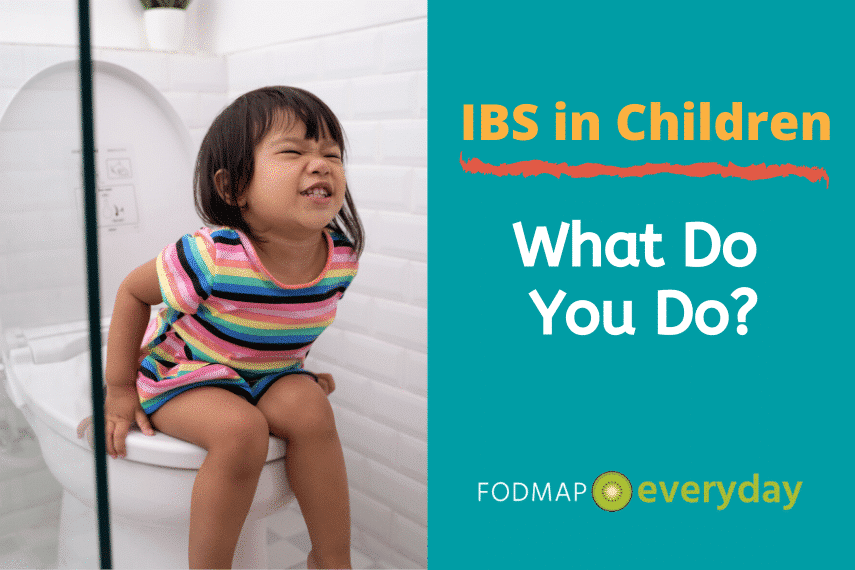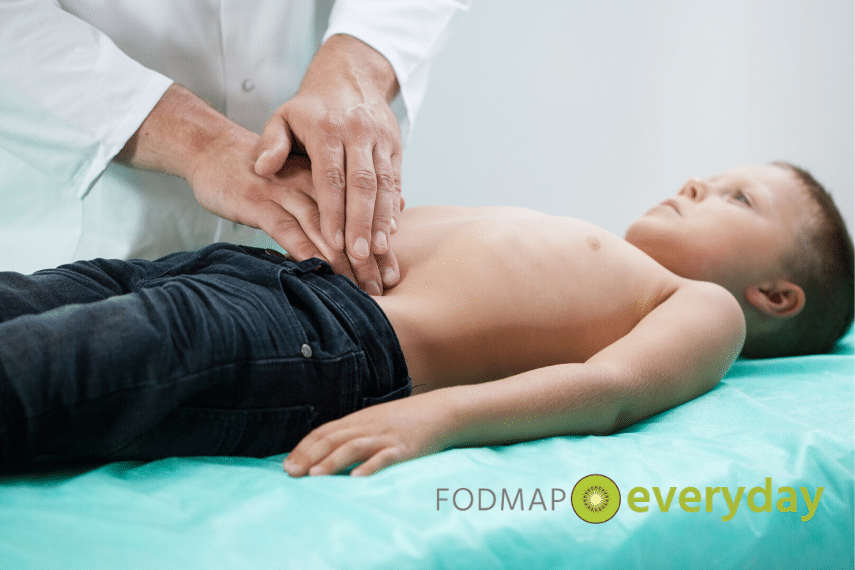IBS in Children: What Do You Do?
So you suspect your child has IBS. You may be wondering what to do next – or first?
As a dietitian moderator on several Facebook groups, and certainly in my own clinical experience, I encounter many parents with children experiencing digestive issues. Sometimes they have received an IBS diagnosis, other times the parents or caregivers are just at the end of their rope, with a sick child who is in pain, and they are desperate for answers.

- IBS in Children: What Do You Do?
- Step One, Obtain a Proper Diagnosis
- IBS symptoms in children include:
- Each Child Is Unique – So Is Their IBS Health Plan
- IBS Treatment Options for Children
- High Risk Children
- Before Starting The Low FODMAP Diet
- Pay Attention to Timing
- Stay Hydrated
- Do Not Forget About Fiber!
- Assemble Your Team
- Utilizing the Low FODMAP Diet Is Not The Same For Everyone
- Popular High FODMAP Foods
IBS can be debilitating for anyone. For children, who are sometimes so young that they cannot verbalize what the issues are, it can feel like an especially distressing situation for all involved.
Let’s look at the best way to handle this situation.
Step One, Obtain a Proper Diagnosis
First and foremost, it is important to ensure your child has an IBS diagnosis from a medical doctor. A proper diagnosis is imperative before implementing any dietary changes.
An IBS diagnosis in children, like with adults, is a diagnosis is based upon symptoms, after other medical issues are excluded. Children are often screened for celiac disease, IBD (inflammatory bowel disease), cancer, gastritis, peptic ulcer disease and iron deficiency. Testing for Eosinophilic esophagitis (also known as EoE, which is a chronic, allergic inflammatory disease of the esophagus) and food allergies are conducted more often than for the adult population.
[bctt tweet=”IBS is this most common functional gut disorder amongst children and adults. IBS symptoms present very similarly among children and adults, often waxing and waning based on dietary habits, stress, and lifestyle habits.” username=”FODMAPeveryday”]
The Rome IV Criteria and additional testing to rule out other GI related disorders is common when diagnosing both adults and children with IBS. There is limited data regarding the prevalence of IBS in children, studies suggest incidence ranges from 3 to 19% in children and 10-15% in adults worldwide. While IBS does not cause any physical damage it can affect quality of life across all ages.
The Rome IV Criteria dictates that a child would have to have abdominal pain for at least 4 days per month, which is associated with defecation, change in stool frequency, or a change in stool appearance for a minimum of two months before a diagnosis is confirmed. IBS subtypes are defined as IBS-C (constipation), IBS-D (diarrhea) , IBS-M (mixed), and IBS- U (unclassified) based on prominent symptoms.
 IBS symptoms in children include:
IBS symptoms in children include:
- Abdominal pain or tummy pain
- Bloating
- Abdominal distention
- Excessive gas
- Mucous in the stools
- Diarrhea
- Constipation
- Stomach cramping
- Incomplete bowl movements
Most often symptoms coincide with consumption of food.

Each Child Is Unique – So Is Their IBS Health Plan
There is not a one-size fits all approach when addressing IBS in children. Your health care provider can help devise a plan that is best for your child based on several factors such as:
- Your child’s age
- Medical history
- Severity of IBS
- Progression of IBS symptoms – how slow or fast have symptoms appeared.
- Tolerance to previous medications and medical treatments
- Family history – do any family members have GI-related disease such as IBD, celiac, etc?
- Have there been any stressful events in child’s life? If yes, did symptoms appear or worsen around this time?
- Parent’s opinions of the best treatment plans since family support is necessary.
- Growth and development, a child with IBS often has normal growth patterns. Suboptimal growth may trigger further medical testing to screen for other problems.
IBS Treatment Options for Children
While the low FODMAP diet is one treatment option, there are several other options that may need to be explored.
- Medications such antidiarrheals, antispasmodic, antidepressants, anti-reflux, and laxatives.
- Antibiotics such as Rifaximin
- Stress Management
- Psychological therapy – counseling
- Gut directed hypnotherapy
- Yoga
- Regular exercise
- Probiotics may be considered based on symptoms
- Fiber Modification – changing the quantity and type of fiber sources consumed to help regular bowels.
- Bowel training – teaching children to empty their bowels at specific times.
- Single food diets may be implemented first, such as a lactose-free diet or low fructose diet.
- Change in meal size – smaller, more frequent meals may be better tolerated than large meals.
- Avoidance of fatty foods, a low fat diet may help improve symptoms.
- Avoidance of gas producing foods such as cruciferous vegetables and beans
- Caffeine free diet. Soda, tea, and coffee often contain caffeine.
- Peppermint oil has been shown to improve IBS symptoms in children and may be encouraged. Tummy Drops are often well tolerated by kids.
- Ensuring your child’s diet does not contain excessive artificial sweeteners such as sucralose, aspartame, and sugar alcohols which are often found in many “diet”, “sugar-free” and “light” foods and beverages.
IBS was often treated with low fructose, low lactose, and low sorbitol diets, however a low FODMAP diet has proved to be effective in children in recent years. There is evidence that a low FODMAP diet is an evidence based approach to reduce IBS and functional gut disorder symptoms.

High Risk Children
Sometimes it is not appropriate for a child to not undergo a low FODMAP diet. Such reasons include:
- Selective eating habits – if your child accepts only limited food choices a low FODMAP diet may further restrict acceptable food choices, placing a child at risk for nutrient deficiencies and weight loss.
- Disordered eating habits and ARID (Avoidance/Restictive Food Intake Disorder) are also contraindications for implementing a low FODMAP diet.
- Children with failure to thrive and who are underweight should not undergo a low FODMAP diet.
Before Starting The Low FODMAP Diet
Ensure your pediatrician is in agreement that a low FODMAP diet is appropriate. Prior to any dietary changes it is important to ensure your child is consuming a balanced diet including appropriate servings sizes from all the five good groups.
Portions & Food Group Choices Count
Portion sizes vary based on age and are often smaller than portion sizes defined on the food label.You will be able to find appropriate serving sizes based on your child’s age on this site.
Here is a general idea of a balanced daily diet:
- Milk and dairy products: 3-4 servings
- Meat, fish, poultry, or equivalent: 4-8oz
- Fruits and vegetables: 4-5 servings
- Grains: 3-5 servings
Pay Attention to Timing
Meal timing is also important. Your child should be eating at regular meal times, versus going long periods if time between meals of skipping meals. Snacks should be planned one and a half to 2 hours before meals to allow for proper digestion.
Stay Hydrated
Fluid is essential for a healthy digestive tract. Ensure that your child is consuming adequate fluid based on gender and age. Check here to determine your child’s fluid needs.
Ideally the majority of your child’s beverages should be coming from water. Milk and many fruit juices are high FODMAP. Be sure to incorporate calcium rich beverages such as lactose-free milk daily.
You can get more ideas for increasing hydration in children in this article from our friends over on Kitchen Stewardship – Signs of Dehydration in Children: How to Tell if Your Kids Are Dehydrated and What to Do About It!
 Do Not Forget About Fiber!
Do Not Forget About Fiber!
The Academy of Nutrition and Dietetics recommends 5 grams + your child’s age to be their daily fiber goal. So if my child is 9 years old, she would need 14 grams of fiber per day.
Fiber can help with constipation and diarrhea based on the fiber sources. Your dietitian will be able to provide specific recommendations of fiber rich foods such as oats, banana, citrus fruits, strawberries, and potatoes.
A specific fiber supplement such as psyllium, partially hydrogenated guar gum (PHGG[2] ), acacia, or methyl cellulose may also be recommended by your health professional. Use caution with “fiber supplements” since many contain high FODMAP ingredients that can worsen IBS symptoms. And be sure to drink enough water when boosting fiber intake.
You May Want To Read: Top 5 High Fiber Low FODMAP Foods and Fiber and IBS: What You Need To Know
Assemble Your Team
Find a dietitian to help create and navigate a plan for both you and your child before starting the low FODMAP diet. Ideally a FODMAP trained pediatric dietitian would be an ideal choice.
Please see our dietitian directory to help locate a dietitian.
If you are unable to locate a FODMAP trained pediatric dietitian seek the help from a local pediatric dietitian to ensure your child is eating a healthy diet, growth is trending appropriately and to review typical eating habits and patterns to better understand your child’s food diet.
A pediatric RD can help ensure your child is consuming adequate fiber, hydration, and other factors essential for healthy digestion. Ask your pediatric RD if he/she has FODMAP knowledge and would be willing to help you and your child navigatethe low FODMAP diet or would like to refer to a more specialized RD. You can also ask a FODMAP trained RD is he or she would be willing to work with you AND your pediatric dietitian, this may improve the comfort level of the FODMAP trained RD if she/he works primarily with adults.
Utilizing the Low FODMAP Diet Is Not The Same For Everyone
It is recommended for children to adopt a “simplified” or “light” low FODMAP diet versus a stricter version of the low FODMAP diet. Your dietitian can help identify frequently consumed high FODMAP foods and provide low FODMAP alternatives based on food preferences.
While it is not appropriate for the whole family to adopt a low FODMAP diet, it is encouraged to modify family meals, such as dinner, to be low FODMAP so your child feels inclusive. Extra time and planning will be required when your child is eating outside of the home (school, daycare, parties, restaurants, etc).
Read our article about back to school and low FODMAP diet for tips and tricks. Please remember that a low FODMAP Diet is not a no FODMAP diet; reducing the frequency and volume of high FODMAP foods often yields a reduction in symptoms.
You May Want To Read: Let’s Get Ready For Low FODMAP Back-to-School!
The Elimination Phase of the low FODMAP diet should be short and kept to a minimum; the goal is to minimize symptoms so one can slowly Challenge high FODMAP foods/groups to help determine triggers. A simplified challenge is also recommended with children. Your dietitian can help guide you and provide appropriate challenge foods and portion sizes based on your child’s age. Challenges should be completed when your child is at home and in a relaxed environment. If your child fails a FODMAP challenge be sure to reintroduce at a later time to reassess since our FODMAP triggers can change over time. Your dietitian can recommend appropriate timing for re-challenges.
It is also important to manage ones expectations. As with adults, IBS symptoms wax and wane and often “perfection” is not achievable. Break through symptoms will likely occur from time to time.
Popular High FODMAP Foods
Lactose
Children consume more dairy than adults. Take into consideration frequently consumed foods such as milk, yogurts, and ice cream. Fortunately there are many lactose-free alternatives that are suitable on the low FODMAP diet.
Fructose
It is everywhere and children consume more fructose on average than adults. Fructose is found in common kid-friendly foods such as fresh fruit, dried fruit, fruit juices, gummy snacks, and sweetened beverages and as such are easy to consume in excess. Children under the age ten have a reduced capacity to absorb fructose, which can increase IBS symptoms.
Polyols
Also referred to as sugar alcohols, these are found in sugar-free gum, mints, chewable and liquid-based vitamins and supplements, plus stone fruits. Be sure to review your children’s vitamin and supplement ingredients and be on the look out for sorbitol, lactitol, mannitol, and other sweeteners ending in ol. The exception is erythritol, which has been shown to be more easily digested than other sugar alcohols.
Fructans
These are found in wheat products (among other foods) and can easily find a way in every meal your child eats – think waffles, pancakes, sandwiches, pasta, and more. While there are low FODMAP serving sizes for various wheat products it is easy to overfill the FODMAP bucket with fructans resulting in IBS symptoms. Fructans are also in onion and garlic so be on the lookout not only for the raw vegetables themselves but garlic and onion powder. Salad dressings, soups, sauces and many condiments often contain these fructan-laden ingredients. Occasionally the amount is small enough per recommended portion (such as with ketchup) that they are considered low FODMAP. Use your Monash app for more detailed information and discuss strategy with your RD.
You May Want To Read: High FODMAP Foods With Low FODMAP Serving Sizes
RESOURCES:
Here are a few resources to help you and your child:
- IFFGD (International Foundation for Gastrointestional Disorders) About Kids GI
- GI Kids Nutrition & Constipation
- Monash University FODMAP Diet app
We hope this article helps you and your child find the right therapy and team to better manage their IBS symptoms so there are far and few bad tummy days.
 IBS symptoms in children include:
IBS symptoms in children include: Do Not Forget About Fiber!
Do Not Forget About Fiber!






